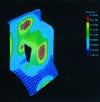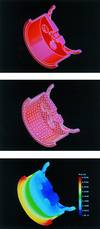Finite element analysis now within reach for all
June 2000

Global competition increasingly places pressure on manufacturers to get their products off the drawing board and to market quickly. More and more they find a competitive edge in the use of 'soft prototyping' with finite element analysis (FEA).
Soft prototyping describes the ability to predict the behaviour of a proposed design without having to build a physical prototype and subject it to tests. The process of simulating the behaviour of designs in their real life operating conditions without actually building a model can save you thousands of dollars – both in materials and human hours. Not to mention that you can then test more design concepts in a shorter period.
Originally, only giants such as the defence and automotive industries – armed with bottomless budget pools - used FEA. But any organisation that designs and manufactures discrete goods can take advantage of this technology to produce better products faster than ever before. And with the introduction of the very affordable Cosmos/M Basic System (from Mecad), analysis no longer belongs to the few and mighty.
Products come in all shapes, sizes and levels of complexity. Cosmos/M can help the manufacturer create a better conceptual design regardless of what is being designed or the size of the budget.

A progression of a model through the analysis process with Cosmos/M: 3D geometry of a sports car front wheel rim, the same model as meshed and the resultant displacement plot of the part - model courtesy of Parametric Technology Corporation
One program for both novice and power users
Unlike other established FEA codes, Cosmos/M offers a powerful combination of brawn and ease of use. All configurations are based upon the Basic System which offers a CAD-like pre and postprocessor together with static and dynamic analysis capabilities. The user can add other analysis capabilities on a modular basis, including advanced dynamics, nonlinear statics and dynamics, fatigue, steady-state and turbulent fluid flow, heat transfer, electromagnetics and design optimisation. With these capabilities, it is possible to build a system that truly meets any analysis needs.
Engineers want easy-to-use systems because the vast majority of them perform analysis infrequently. Some might think that a typical engineer uses FEA every day. Not at all. A recent survey of over 1000 Cosmos/M users shows that more than 75% of them described their use of FEA as 'over once a month'. Because so few of them use the software daily, the majority want a program that is easy to learn and hard to forget. With all its power, Cosmos/M gives users an intuitive interface that makes it easy to conduct analysis.
Cosmos/M's integrated graphical user interface, Geostar, makes it easier to create models and display analysis results regardless of the platform of choice: DOS, Mac, Windows 95 and NT or Unix. It even makes it easier to transfer CAD models into Cosmos/M so designs do not have to be recreated. Such time saving devices as automatic and adaptive meshing help to create models quickly, preventing duplication of design effort. Cosmos/M reduces time spent on mundane tasks, freeing more for evaluating and optimising designs.
The package has on-line help, pull-down menus, icons and descriptive command names, allowing users to jump-start their use of Cosmos/M. The Unix, Windows 95 and NT (available with Version 1.75 and subsequent releases) versions offer a Motif-based interface for even greater ease of use. New on-line documentation with active hypertext links complements the existing on-line help. After just three days of formal training, most new users are ready to put the system to work for them productively.
Fuelled by traditional FEA techniques, the Cosmos/M Basic System consists of Geostar, Star and Dstar. Since its introduction in 1985, it has provided a user-friendly code as an advanced alternative to mainframe-based FEA systems. Its linear statics module, Star, calculates stresses, strains and deformations while supporting an extensive element library. Star provides numerous advanced features such as composites, contact between bodies using gap elements, substructuring, sub-modelling, fluid-structure interaction, axisymmetric models subject to asymmetric loading, and much more. In contact problems the program tracks the change in the gap opening and when the gap closes, the program treats it as a contact point and calculates local deformation and stresses accordingly. Friction coefficient can be added to treat situations where sliding occurs between the contacts.
The submodelling option makes it easier to obtain accurate results in areas of stress concentration. Here is how it works: if, after running a problem with a relatively coarse mesh, areas are found where stresses may not have been calculated accurately due to sharp corners, geometric or load nonuniformity or boundary conditions, those areas can be defined as submodels. The submodel mesh can be refined and the problem rerun only for the submodel. The Basic System’s dynamic module, Dstar, offers frequency and buckling analyses practically at a touch of a button.
Whatever the specific analysis needs are the Cosmos/M Basic System offers an effective testing ground for ideas.
Mecad
(012) 665 1400
Others who read this also read these articles
A challenge for motor manufacturers
Computer-based integration of design and manufacturing is essential for the '24-month car' to be achieved[ October 2004 ]
Prominent new lifestyle centre for Cape Town's financial district
Dimension Modeling created the 3D interior models that were then also rendered out for internal views of the apartments as well as the atrium and foyer areas[ August 2004 ]
Anglo Platinum - automating repetitive design tasks with Solid Edge
Solid Edge Insight is an innovative solution that seamlessly integrates CAD, design management and Web-based collaboration into a single tool that is easy to implement and easy to manage[ June 2004 ]
Styled plastic products and packaging - main pains and solution initiatives
To put the product and the customer front and centre, where they belong, all disciplines must sit at the same virtual table, sharing the same information and seeing the same vision[ June 2004 ]
Evolution from 2D to 3D - a product development manager's perspective: Part II
Whereas 2D CAD shortens time scales to some extent, 3D CAD goes much further, directly supporting the whole product development cycle, speeding up every activity and increasing the quality of design by removing many sources of inaccuracy and error[ April 2004 ]
Multiphysics analysis to simulate cylinder head
Adiabatics Inc used multiphysics FEA software from Algor to study the thermal and structural behaviour of a cylinder head for a diesel engine that would provide reduced heat rejection and increased power density while maintaining its superior fuel economy and lower operating cost[ December 2003 ]
Unigraphics NX 2: the next generation
What the NX 2 release sees is the integration of the use of networks of curves to define surface boundaries and existing geometry, and freeform surface modelling into the core of Unigraphics but with a few rather neat extras as well[ October 2003 ]
Geopak helps create Festival City
Geopak Site allows one to handle with ease live 'what if' scenarios with the client and other design team members[ August 2003 ]
Others who read this also read these news items
Lockheed Martin selects preferred MCAD tool
[ December 2005 ]
Grand scale initiatives at Ethekwini Municipality
[ October 2005 ]
Robert Mugabe Avenue in Windhoek gets extension
[ August 2005 ]
Strand7 nonlinear analysis used to solve bracket deformation problem
[ August 2005 ]
Scania optimises truck components
[ February 2005 ]
Delcam's PowerMILL chosen for A1 Grand Prix engine manufacture by Zytek
[ February 2005 ]
A first of its kind: irrigation development, a R3,7-billion SADC project
[ February 2005 ]
Arup lands Tianjin Olympic Aquatic Centre project
[ December 2004 ]
Others who read this also read these regulars
Search Site
Subscribe
Previous Issues
Other Technews Publications
Other Technews Buyers Guides
 |  | Copyright c1995-2009 Technews Publishing (Pty) Ltd.. All rights reserved. |